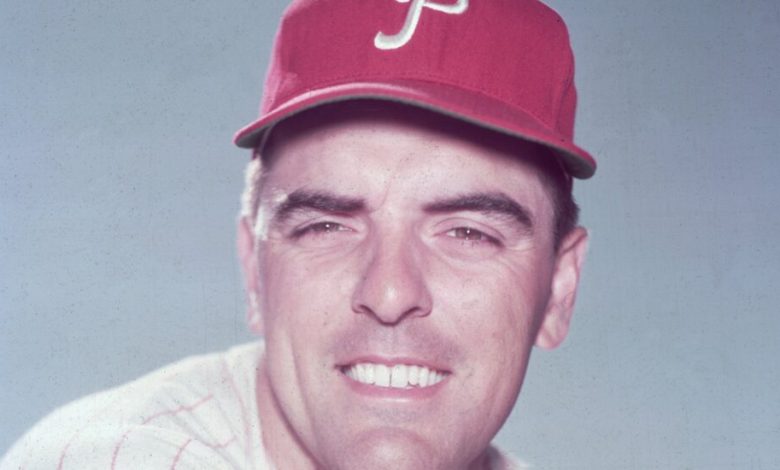Curt Simmons, Last of the Phillies’ Whiz Kids, Dies at 93

Curt Simmons, a pitcher who helped propel the 1950 Philadelphia Phillies to the franchise’s first pennant in 35 years and went on to become one of baseball’s leading left-handers in his 20 major league seasons, died on Tuesday at his home in Ambler, Pa. He was 93.
His daughter, Susan D’Acquisto, confirmed that death. She said that Simmons had a hip replacement years ago that had been compromised and caused him to become bedridden and ultimately debilitated.
Simmons was the last survivor of the youthful 1950 Phillies team known as the Whiz Kids, which captured the National League pennant on the final day of the season, only to be swept by the Yankees in the World Series.
While pitching for the Phillies, Simmons was a three-time All-Star. In his mid-30s, after coming back from elbow surgery, he pitched for the St. Louis Cardinals’ 1964 N.L. pennant winners and started twice in their seven-game World Series victory over the Yankees.
Relying on his fastball early on and later reinventing himself with a variety of pitches that kept batters off stride, Simmons had a career record of 193 victories and 183 losses.
In the summer of 1950, when he was 21, he teamed with the future Hall of Fame right-hander Robin Roberts, who was 23, and a lineup including another future Hall of Famer, Richie Ashburn, 23, in center field and the hard-hitting Del Ennis, 25, in left field. That Whiz Kids team won a long-sought pennant after finishing 16 games behind the league champion Brooklyn Dodgers in 1949.
Simmons had a 17-8 record for the 1950 Phillies in early September, when the Army National Guard unit he had joined after the outbreak of the Korean War in late June was called up for active duty.
The Phillies, managed by Eddie Sawyer, were one game ahead of the Dodgers going into the season’s final Sunday when they captured the N.L. pennant with a 4-1 victory at Ebbets Field on Dick Sisler’s 10th-inning three-run home run.
While the players were celebrating their stunning pennant victory, they phoned Simmons at his Army base in Pennsylvania.
“The boys from the party called me from the Warwick Hotel in Philly,” Simmons told The Palm Beach Post in 2009. “Some of them were coherent, some weren’t.”
Simmons and Roberts, a 20-game winner in 1950, were the anchors of the Phillies’ starting rotation. The pitching staff also included Jim Konstanty, a rare “old-timer” on the ball club at 33, who won 16 games, all in relief, and was named the N.L.’s most valuable player; and Bob Miller, who won 11 games and was runner-up for rookie of the year.
But the Phillies did little at the plate in the World Series, scoring only five runs in losing four straight to the Yankees.
“Roberts and Simmons always rose to the occasion,” the catcher Andy Seminick told Danny Peary for the oral history “We Played the Game” (2004). “We’d go into town for a three-game series, we were confident we’d win at least two games.”
Hank Aaron regarded Simmons as one of the best fastball pitchers he faced. He also remembered how deceptive he could be.
“I wasn’t fooled very often,” Aaron told The New York Times in 1976, but “Curt Simmons was the toughest to read because he hid the ball so long behind his hips.”
The Phillies released Simmons in May 1960. The Cardinals signed him a few days later. He posted an 18-9 record in 1964.
“Curt knows the hitters better than anyone in the league,” Johnny Keane, the Cardinals’ manager, told Sports Illustrated that June. “He has the curve, the slider and the change, and he can reach back and get the fastball.”
Simmons joined with Bob Gibson and Ray Sadecki on the pitching staff that helped take the 1964 Cardinals to a World Series title. He started Games 3 and 6 and pitched well, but the Cardinals lost both games before beating the Yankees in Game 7.
He later pitched for the Chicago Cubs and the California Angels. He retired in 1967.
Curtis Thomas Simmons was born on May 19, 1929, in Egypt, Pa. His father, Lawrence, worked in a cement mill, and his mother, Hattie (Peifly) Simmons, was a homemaker.
A star pitcher at Whitehall High School in Pennsylvania’s Lehigh Valley, he was signed by the Phillies to a $65,000 bonus, a huge figure for the time, when he graduated in 1947. He pitched in one game for the Phillies that year, then had losing records in the next two years before flourishing in 1950.
Simmons pitched for an Army baseball team until his discharge before the 1952 baseball season. He won 14 games that year and led the N.L. in shutouts, with six. He won 16 games in 1953, though he missed a month after losing part of a toe in a lawn mower accident.
After leaving baseball, Simmons was a partner with Roberts and others in a golf course in Ambler, Pa. He became the last living Whiz Kid when Miller, his pitching corps teammate, died in November 2020 at 94. During their last years, Simmons and Miller, who was living in Michigan, kept in touch by phone, reliving their glorious summer of 1950.
In addition to his daughter, Simmons is survived by his sons, Timothy and Thomas, and seven grandchildren. His wife, Dorothy (Ludwig) Simmons, died in 2012.
Simmons long remembered his disappointment over missing the 1950 World Series.
“Two days before the Series began, they called me into the Army office and said they’d give me a 10-day leave without pay,” he told The Allentown Morning Call in 2014. “I wasn’t eligible to pitch because the rosters had to be set up three days before the Series, so I pitched batting practice.
“I think I put the guys in a slump because I was pitching pretty good.”
Alex Traub contributed reporting.